Just when you thought I was done cooking up ethnic food, here I come once again with another attempt to harness another culture in my humble kitchen. This time I took on the beast that is beef rendang, a Malaysian/Indonesian dish that seems to involve every spice under the sun. I was inspired by a commenter here who suggested I try it, and since I’d never heard of rendang, I looked it up on the internet. The more I read about it, the more delicious it looked. Therefore, I decided to give it a whirl on Thursday and see what I could pull off. The results? Well, you’ll just have to read to find out.
The whole concept behind beef rendnag â€â€Ã‚ from what I could gather â€â€Ã‚ is that it’s a reverse-braised dish. The beef is slathered with a spice paste, plunked in coconut milk, and then slowly cooked over many hours until the liquid as evaporated and the meat is left with nothing to do but fry in its own oils. Easier said than done…
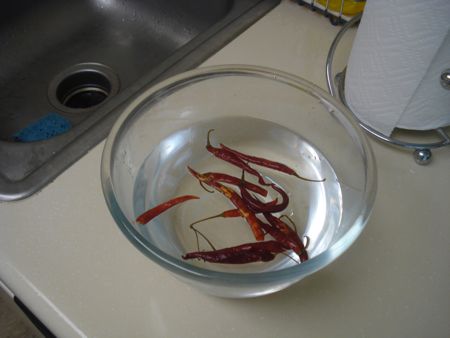
The recipe I used called for several chile peppers. Being the economical chef that I am, I bought a bag of dried arbol chiles for about $1.50 and soaked eleven of them in water.
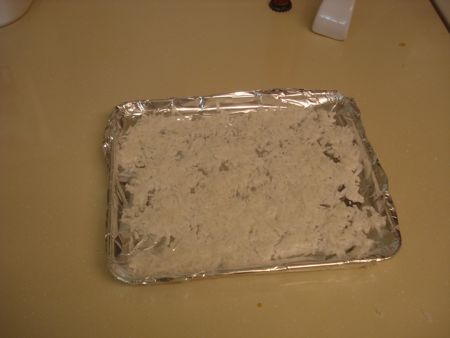
Meanwhile, I prepped some shredded coconut to go into the toaster oven for some browning action.
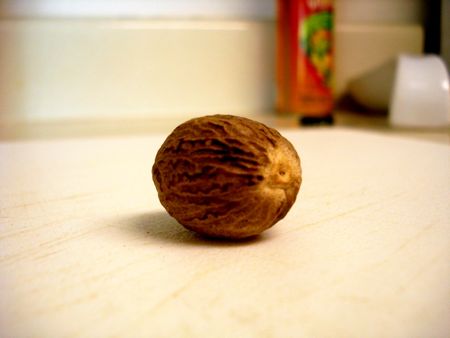
Next order of business: crack a whole nutmeg.
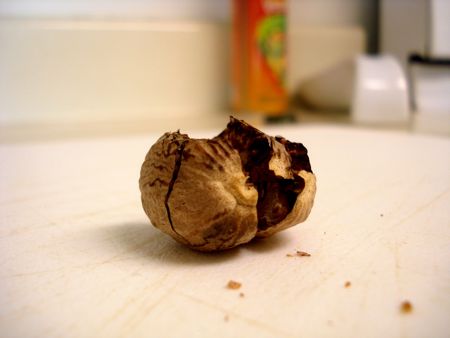
Success.
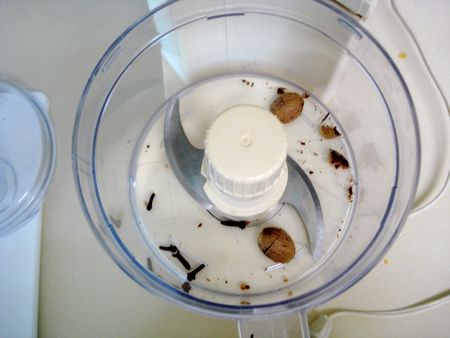
Next it was time to get this spice paste going. First I had to grind up the nutmeg and five cloves.
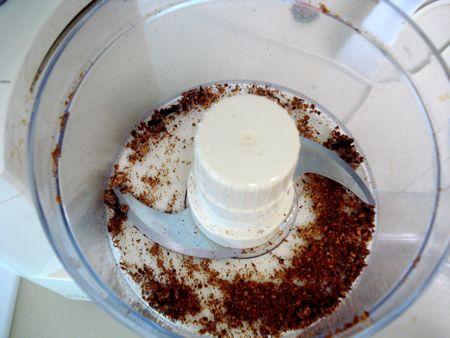
Overall, it was a successful effort, but damn those cloves. They did not play well.
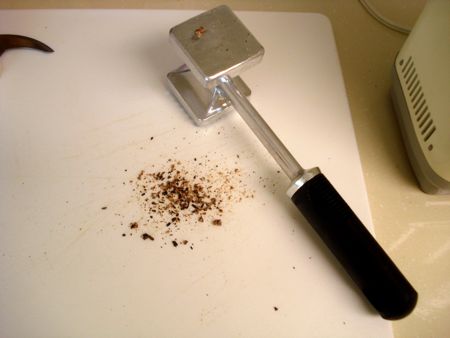
I removed the chunkiest bits that simply would not grind down and took matters into my own hands.
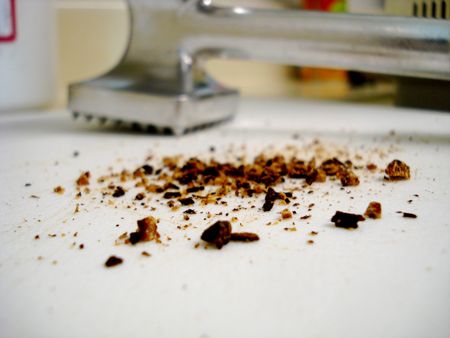
And yet those cloves still remained intact. This was becoming entirely too frustrating. I decided to move on.
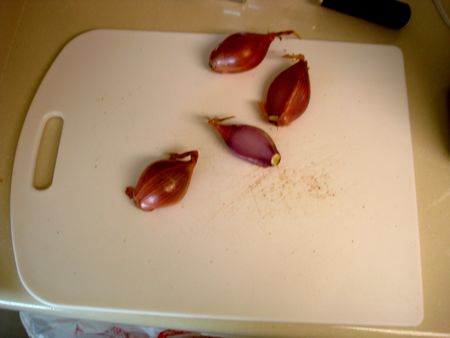
Time to chop up some shallots coarsely.

Tears ensued.
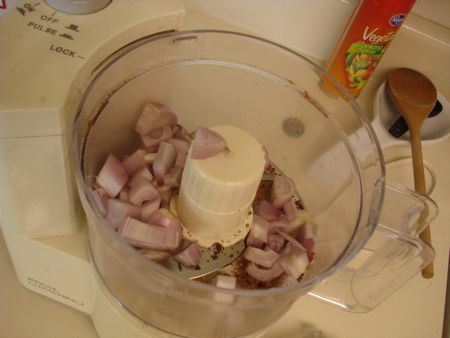
Somehow I managed to persevere and get all the shallots into the processor.
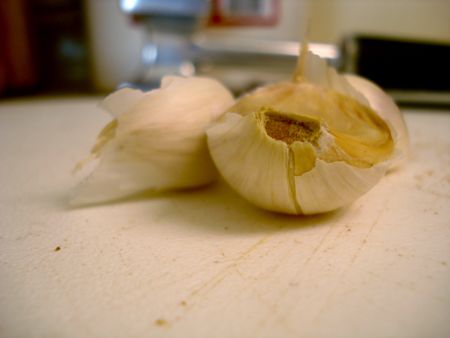
Next up: garlic.
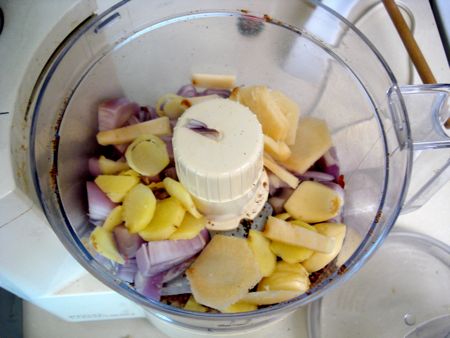
Then some ginger and galangal.
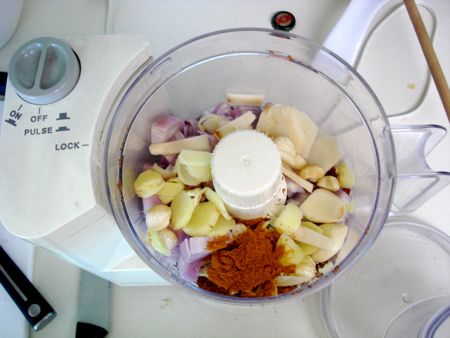
And then some turmeric and macadamia nuts.
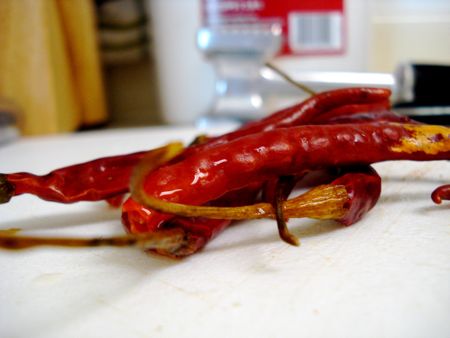
Time to engage the chiles.
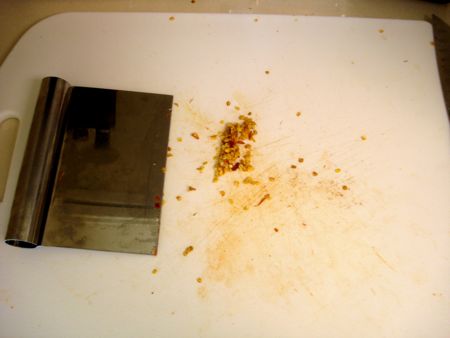
In an effort to spare myself a meal of sweating, sniffling, and general pain, I deseeded the chiles (leaving some in for a bit of spice).
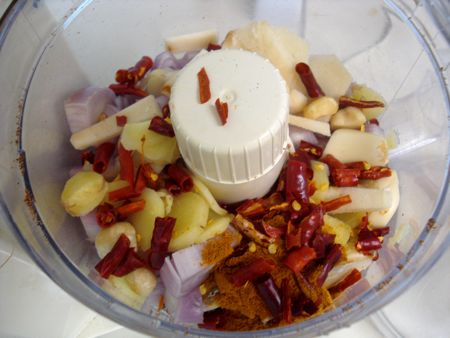
The mixture is ready to become paste.
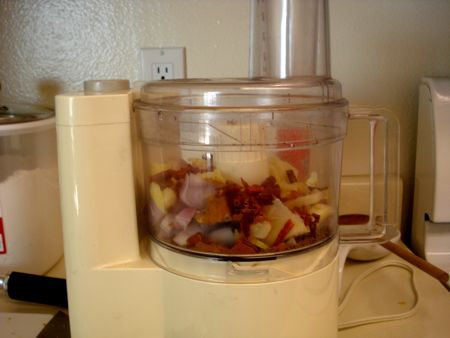
Lid is on. Pulsing to commence.
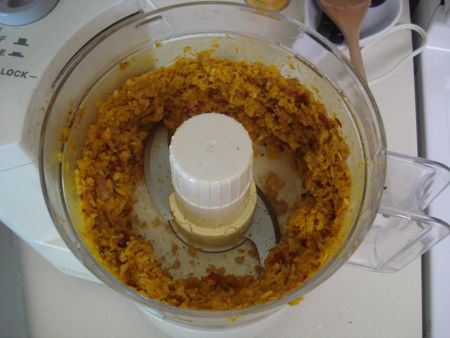
A few minutes later, I’m well on my way to paste. Unfortunately, this is about as fine as I can get it. I decide to step it up and transfer the batch to the Magic Bullet (note for next time: just use the Magic Bullet from start to finish).
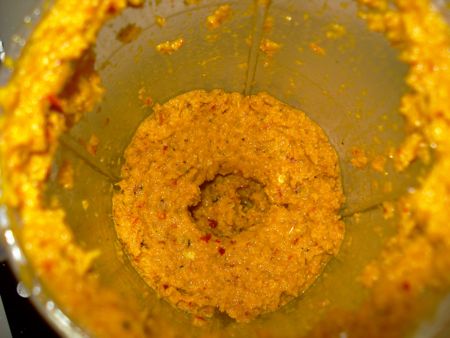
Much better.

Two pounds of chuck. It was only about thirty cents more expensive than the stewing meat; so I figured this would be higher quality and I could just cut it up myself.
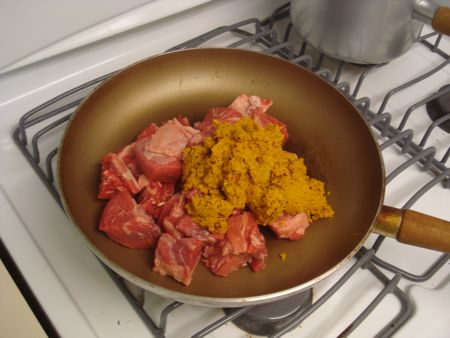
At last, it’s time to start cooking.
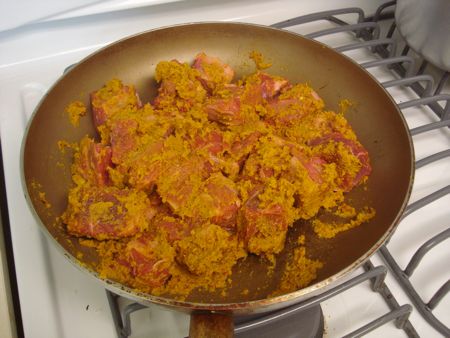
I mix the meat and the paste until well combined.
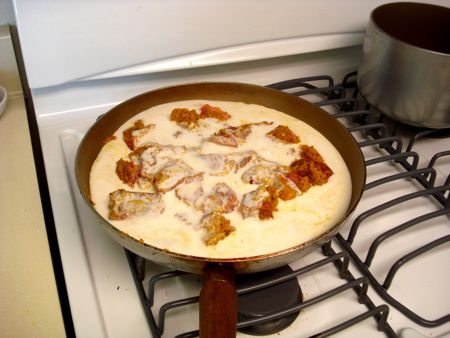
Then I add lots of coconut milk.
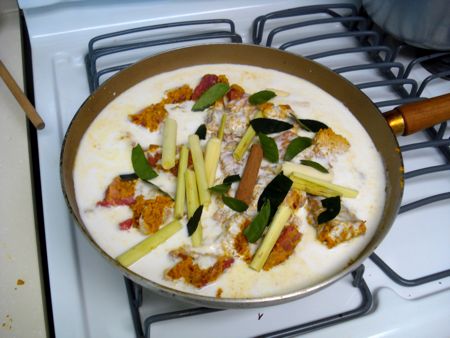
And now some lemongrass and kaffir lime leaves and a cinnamon stick.
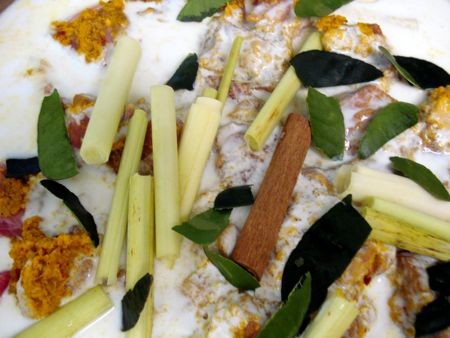
Quite colorful, if I do say so myself.
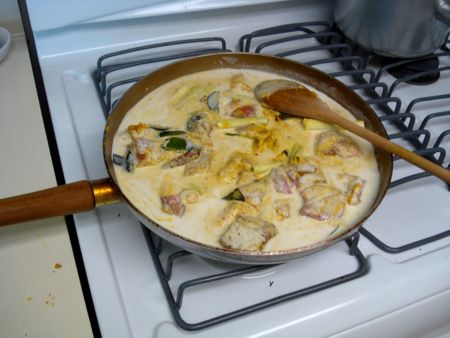
Over a medium flame, I slowly bring the coconut milk to a gentle boil.
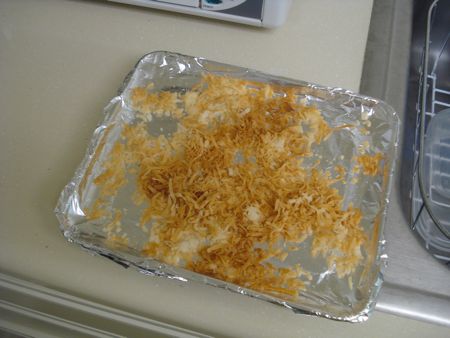
Remember that toasted coconut?
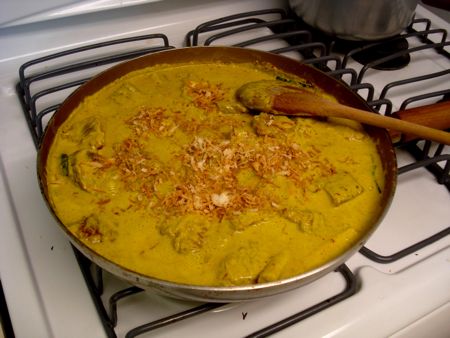
I then add it to the dish and lower the heat. Time for the long, long simmer…
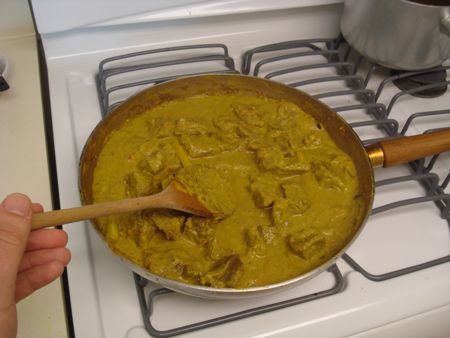
An hour later, the sauce has thickened and darkened a bit. The beef, however, is not particularly tender though.
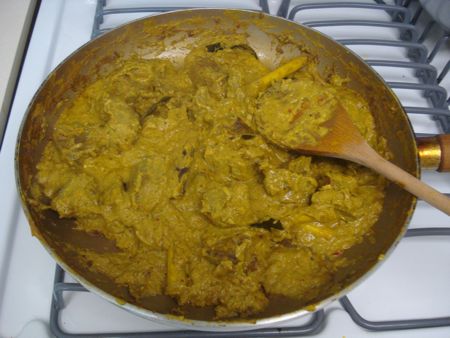
Thirty minutes later, the sauce has thickened even further. I have to stir more frequently to avoid scalding.
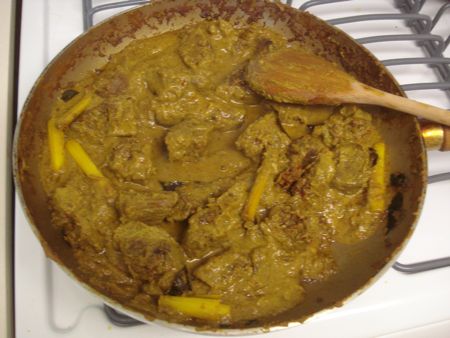
An hour later, the beef is nowhere near tender. I add some water to help it along.
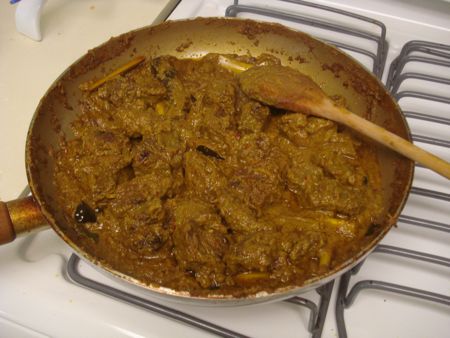
Forty-five minutes after THAT, the color has turned brown â€â€Ã‚ which is what it’s supposed to do â€â€Ã‚ but damn that meat!!! NOT TENDER.
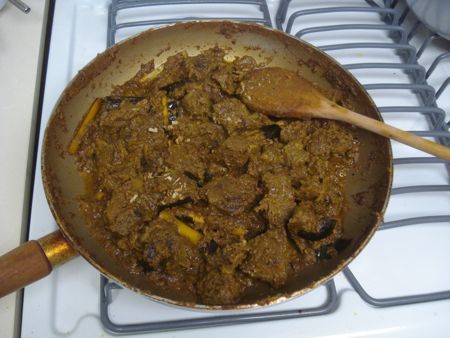
The sauce is where it’s supposed to be, but the meat is not, and quite frankly, I’m sick of adding liquid to tenderize it. At this point, I decide to go against the recipe directions and place a baking sheet over the pan to augment the braising.
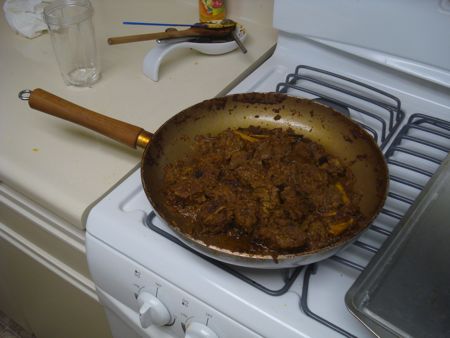
An HOUR later, the meat is somewhat tender. Some pieces are soft, others are a little firmer. But at this point, I don’t care anymore and decide to move onto the next phase…
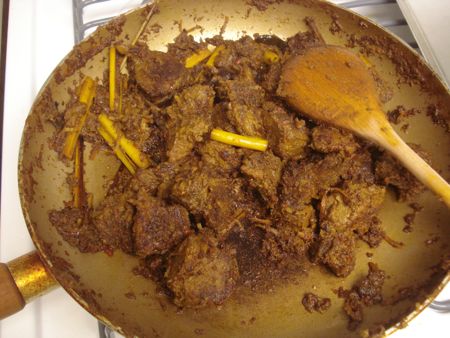
I evaporate the last of the liquid and let the meat brown for a few minutes.
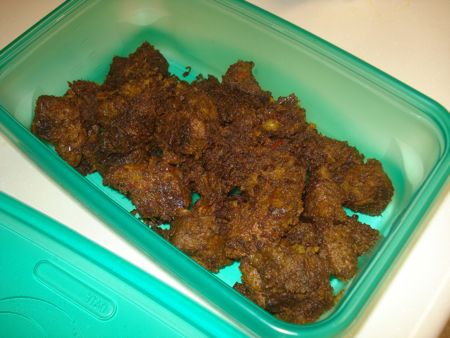
Then it’s out of the pan and into the Gladware. Rendnag isn’t supposed to be served hot but room temperature.
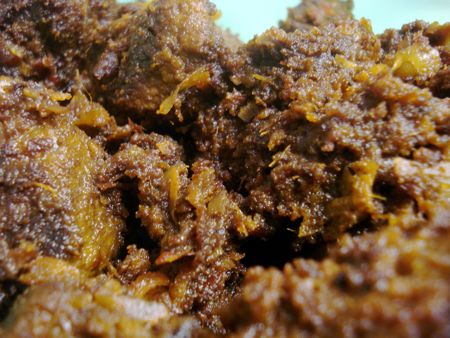
Macro shot.
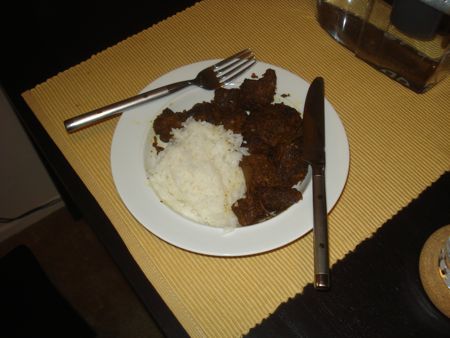
Fast forward to dinner…
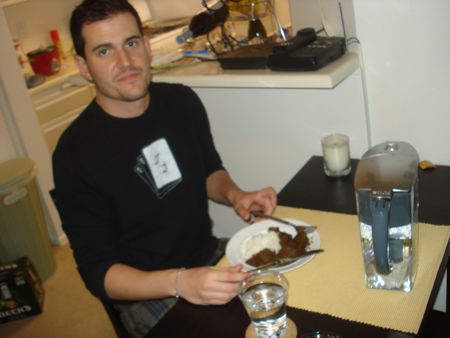
After hours of cooking, I’m more than ready to try the beef rendang.
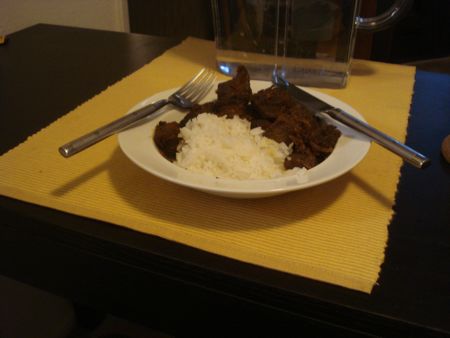
Verdict? Delicious! I mean, how could it not be? The meat simmered in all those spices for an entire afternoon. The tender pieces in particular were amazing. The firmer pieces were also very good, but not quite as awesome. Texture counts for a lot in this dish.
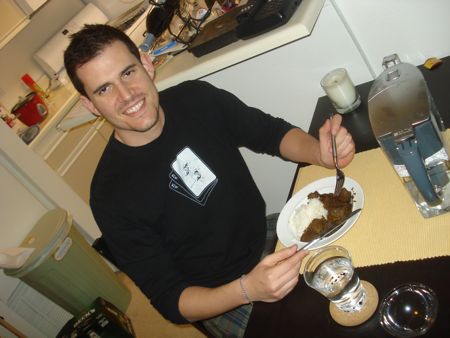
Overall, I’m quite happy with the results. PHOTO BY JASH.
I’m gonna have the leftovers tonight. Apparently rendang tastes amazing two or three days later. I’m very excited.
In terms of the recipe, if I were to make this dish again, I’d cover the meat for the first one and a half or two hours â€â€Ã‚ or until it’s tender  and THEN remove the top and let the liquid evaporate out. Simply using an open skillet (as recommended) let the liquid boil off too quickly without amply workin’ the meat. Taste-wise, however, the dish was perfectly fine. I’m tempted to go into the fridge right now and steal a small piece.
And NOW I’m done with ethnic cooking for a little bit.
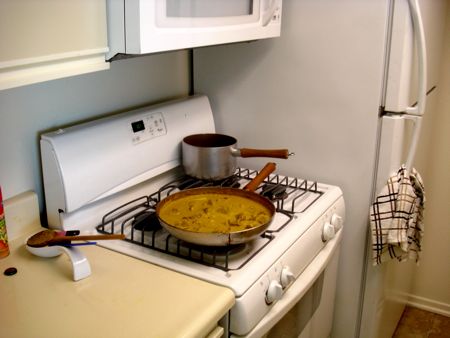
Are you letting Jash share in your meals? Or do you just make him photograph you eating and then do the dishes?
B-Side, I might be in love with you. Men willing to take on the challenge of the rendang are few and far between. This is truly my all-time favorite dish, sorry for not warning you for about how long it actually takes to make. And it’s AWESOME three days later 🙂
Oh yeah, when I was in Australia I found a seasoning packet (for lack of a better term) that cut cooking time dramatically — http://indomart.us/catalog/product_info.php?products_id=230
why does jash lean to the left when he takes pictures?
hb
I have the same rice cooker. soulmates?
You know, it wasn’t a particularly difficult process, and making the paste only took about twenty minutes max. The problem was that the recipe called for an inefficient way to tenderize the meat. I knew the process would take about three hours, but for the meat to not be even close to melt-in-your-mouth tenderness was a bit odd. The key is to just put a lid on it and let it braise like short ribs or whatever.
B,
it is much easier to use Ground Cloves.
Fresh Grated Nutmeg is the best, that and cayenne pepper are the secret ingredients in my mac and cheese.
Wow that looks so delicious. I will never attempt it in this lifetime, I’m far too impatient!
I love rendang, make it at least once a month. Usually ready made paste you can get in Indonesian shops (here in holland there are a lot of them) but sometimes I use a simular recipe.
Had a hard time understanding most ingredients are only know by the Indonesian name. But where did you get this recipe?
“why does jash lean to the left when he takes pictures?
hb”
Because he’s so artsy. Duh.
B-Side – Congratulations on another successful dish – the rendang looked delicious. And can I just say, it seems you would fit right in on Top Chef, particularly with you smart use of the ‘Glad Family of Products’ while you waited for your meal to achieve the proper temperature. Well done!
You lost me at galangal
Up next: Beef Rendering.
Please?
But you won’t eat strawberries?
What size Pepto-Bismol or Rollairds do you keep on hand?
holy crap, you made Rendang from scratch!?!?!???! When I cook it, I use a paste that I get at Ranch 99 (there’s one in Van Nuys, if you ever find yourself in the barrio).
here’s the recipe for my sister’s non-authentic yet delicious version:
http://la.foodblogging.com/2006/01/21/my-sister-jussie%E2%80%99s-fantastic-malaysian-rendang/
Or you can buy it at Singapore’s Banana Leaf at the Farmer’s Market — the cooked dish, not the paste. Beef is much better than chicken for this aromatic curry.